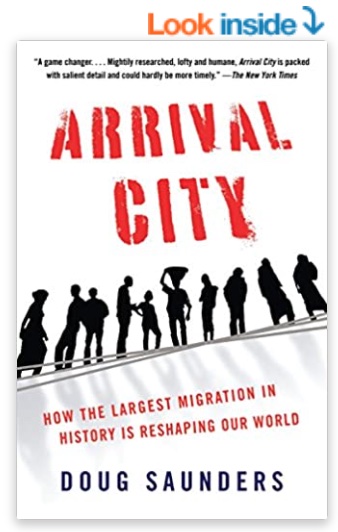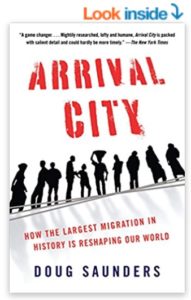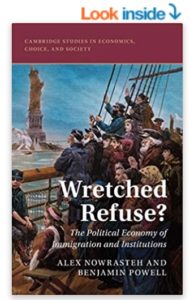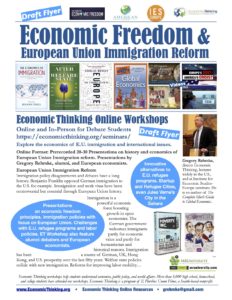If It Matters, Measure It: Millions Migrate to Prosperity

Hundreds of millions in the Great Migration are moving toward better opportunities. People “vote” for better governance with their feet, traveling from dysfunctional and less economically free communities to where labor is more highly valued plus electricity more plentiful, usually in or around cities. The poor at first have only labor to exchange, and start with few commercial skills, and so find low pay in factories or in the informal economy selling goods and services in the shanty towns surrounding cities in the developing world.
 Doug Saunder’s 2012 book Arrival City: How the Largest Migration in History Is Reshaping Our World surveys the migrations to prosperity. You can “look inside” for free on Amazon, or see NYT review. There are similarities across migration stories. Especially recommended is the first chapter on Liu Gong Li, an edge city outside of Chongqing, China. Some 22 million live and work in Chongqing, with million more living in nearby edge cities. Most are or were “economic refugees” from impoverished Chinese villages.
Doug Saunder’s 2012 book Arrival City: How the Largest Migration in History Is Reshaping Our World surveys the migrations to prosperity. You can “look inside” for free on Amazon, or see NYT review. There are similarities across migration stories. Especially recommended is the first chapter on Liu Gong Li, an edge city outside of Chongqing, China. Some 22 million live and work in Chongqing, with million more living in nearby edge cities. Most are or were “economic refugees” from impoverished Chinese villages.
For debaters with the E.U. immigration reform topic, chapter 6 on Istanbul is relevant. Istanbul, now the largest city in Europe, has been a migration success story, thanks to deregulation and land reforms that reduced the appeal of Communism as well as Islamism. According to Saunders, people became less radical when they became land owners. They had long lived “informally” on untitled land without legal titles.
Also in Arrival City chapter 8, “The New City Confronts the Old World,” looks at immigrant enclaves in France, Berlin, and Spain. Excerpts from these chapters are not on Amazon, but Arrival City is inexpensive. In this 2018 presentation, Doug Saunders – Immigration Canada Europe – Making population growth work, he looks at policies helping immigrants better adapt and contribute to city development. Also from 2018 in DW, Migration expert Doug Saunders on the potential of the ‘Arrival City’:
Other stops during his three-year research trip were London’s East End, the notorious banlieues of Paris and the Kreuzberg district of Berlin. Saunders talked to people while observing their lives. He linked his impressions to scientific analyses, and even raised political demands.
And finally, Saunders came up with his daring theory, which says that migration to cities should not be seen as a frightening side-effect of civilization, but rather viewed as progress. In the five years since its publication, “Arrival City” has become a milestone in literature about migration, making Doug Saunders a migration expert.
Doug Saunders is a journalist and his reports on the development of immigrant communities is rich with fascinating stories. Development economists run the numbers on immigration flows, analyzing the positive and negative impacts. Bad people do bad things both at home and in the communities they migrate too. And good people can become disoriented in the strange-seeming communities they migrate too. So some migrants add vibrancy while others create turmoil. Migrants see things and do things differently, bringing perspectives and behaviors from the “old country” to their new communities.
 Recent research in the December 2020 book: Wretched Refuse?: The Political Economy of Immigration and Institutions (Cambridge Studies in Economics, Choice, and Society)and you can also “look inside” on Amazon.
Recent research in the December 2020 book: Wretched Refuse?: The Political Economy of Immigration and Institutions (Cambridge Studies in Economics, Choice, and Society)and you can also “look inside” on Amazon.
Migrating to Economic Freedom
Higher measures of economic freedom reflect wider opportunities for work and enterprise. Economic freedom measures are outlined and compared by country in the Index of Economic Freedom (Heritage/WSJ), Economic Freedom of the World Index (Cato/Fraser), Human Freedom Index (Fraser), and Doing Business rankings (World Bank).
More economic freedom enables innovation to grow more nutritious food, produce better clothes, build new and better housing, improve health care and education. Reducing the regulatory burden would helps most people, but the politics of reform can be complicated. Many reforms that could improve economic growth first disturb people and companies benefiting from the status quo, companies protected or subsidized by the same regulations that slow overall growth.
Migration to More Open Economies
Many in poor communities relocate to cities for higher-paying work opportunities. In larger countries, this migration is from countryside to cities. For smaller countries this migration has often been across borders. Since World War I, migration has remained regulated and restricted. Government programs designed to assist people in need have proven to be a stumbling block for more open immigration. New immigrants from poor countries could qualify for existing welfare programs. If these assistance programs are considered “rights”–as they are in the European Union–then most new immigrants can claim assistance, raising costs for local taxpayers.
In the past and still today, aid for immigrants and refugees comes through networks of local, regional, ethnic, and religious aid organizations. The Sons of Italy, for example, assisted Italian immigrants to America. Ethnic mutual benefit societies provided social insurance and assistance to immigrants throughout American and European history.
Reforming E.U. and U.S. immigration policies can reduce suffering for refugees, and improving economic freedom in poorly governed countries would greatly reduce refugees and asylum seekers.
Foreign aid optimists like economic and activist Jeffrey Sachs call for simply ending poverty with major increases in economic transfers from richer to poorer countries. Smart aid, Sachs argued, could provide the tools, knowhow, and infrastructure for people in poor countries to work their way out of poverty. And without grinding poverty, migration and refugees to the European Union (and U.S.) would decline.
The good intentions of foreign aid confront the challenges of “planners vs. searchers.” Aid planners tend to lack the knowledge needed to reform local legal systems to encourage enterprise. Past posts here. Many past economics of immigration posts here. Various Economic Thinking YouTube presentations on the economics of immigration here.
Flyer for ET 2020 workshops on the E.U. Immigration topic below


1 Response
[…] A previous post on migration emphasized the importance of measuring economic freedom to judge policy reforms effective in reducing barriers to enterprise and prosperity. In that post Economic Freedom Indexes were recommended as tools to measure the benefits of sound money, open trade, lower regulation and taxes, judicial transparency, and other policy categories. […]